The Ingenious Gentleman Sir Quixote of La Mancha is the full title of the Spanish novel by Miguel de Cervantes, but most of us know it simply as Don Quixote, the story of a delusional knight-errant who tilted at windmills. His faithful squire, Sancho Panza, is shown in the foreground of the picture below shouting at Quixote to come back – those are not giants – they are windmills…
The windmills seem to be the least of the quixotic delusions; Don Quixote has read so many chivalric romances that he loses his grip on reality and becomes a knight-errant pursuing a series of quests in an imaginary world of his own creation. How’s that for a table theme?
Wearing an ancient suit of armour and mounted on his aged steed, Rocinante, Don Quixote gets into numerous fights, often coming out much worse for wear, though it seems that his competitor’s horse took it on the chin in this instance.
A knight-errant must have a lady love, of course; Don Quixote settles on a local farm girl as the object of his unrequited affection, renaming her “Dulcinea del Toboso” though she knows nothing of his devotion or her role in this imaginary drama.
The tale continues as he arrives at an inn (a castle in his mind), greets the resident prostitutes (ladies of the castle) and tries to persuade the innkeeper (the lord of the castle) to dub him a knight.
There are many, many fights, with Don Quixote usually being soundly beaten, often left unconscious.
After one such fight, his inert form is returned to his home to recover, and while unconscious in his bed, his niece, the housekeeper, the parish curate and the local barber burn most of his books of chivalry.
This seems to have little effect, however, as he’s soon off again on his adventures. Quixote and his faithful henchman come across an entourage of waggoners transporting lions, a gift from the Governor of Oran to the King. Quixote orders the waggoner to open the cages and drive them out so he can fight them.
The novel concludes with Don Quixote returning home to his village, whereupon he falls very ill and dreams. Upon awakening, he has recovered his sanity, renounces his chivalric ambition and apologizes for the harm he has caused. He dictates his will, including a provision that his niece will be disinherited if she marries a man who reads books of chivalry.
We shall leave Don Quixote to his recovered sanity and go on to the table.
The Quixote plates are antique French Faience by Casemene, a short-lived French manufacturer. There are twelve plates in total and I have managed to snag eleven on eBay – the twelfth plate is elusive. The border is actually green, though it “reads” much more blue.
See what I mean? I styled them with Victorian blue napkins from Williams Sonoma a few years ago.
I tried green napkins in various shades and it just didn’t work.
The natural greens of the flowers were fine, and I used orange parrot tulips for a bit of oomph.
They seemed to work with the bronzey orange-brown tones that form the background of most of the illustrations.
Having figured out the blue napkins, I carried on with the natural tones in my motley collection of Amber Stemmed Depression glass, mostly Morgantown Pattern 7617, with two different etchings…
…and Tiffin Franciscan pattern 15003.iced tea glasses on the right, below.
The dinner plates are Hartley Greens Pierced Rim Creamware, long discontinued, but sometimes available at Replacements.
Thanks for joining me on a Quixotic journey today!
I’m sharing this post with Between Naps on the Porch.

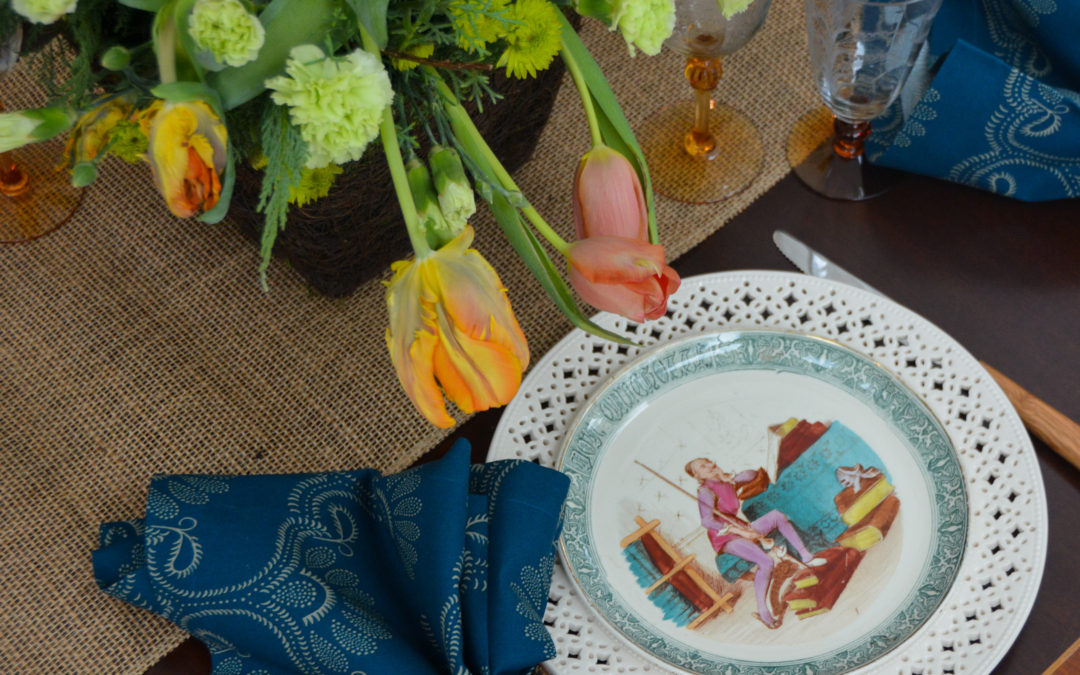

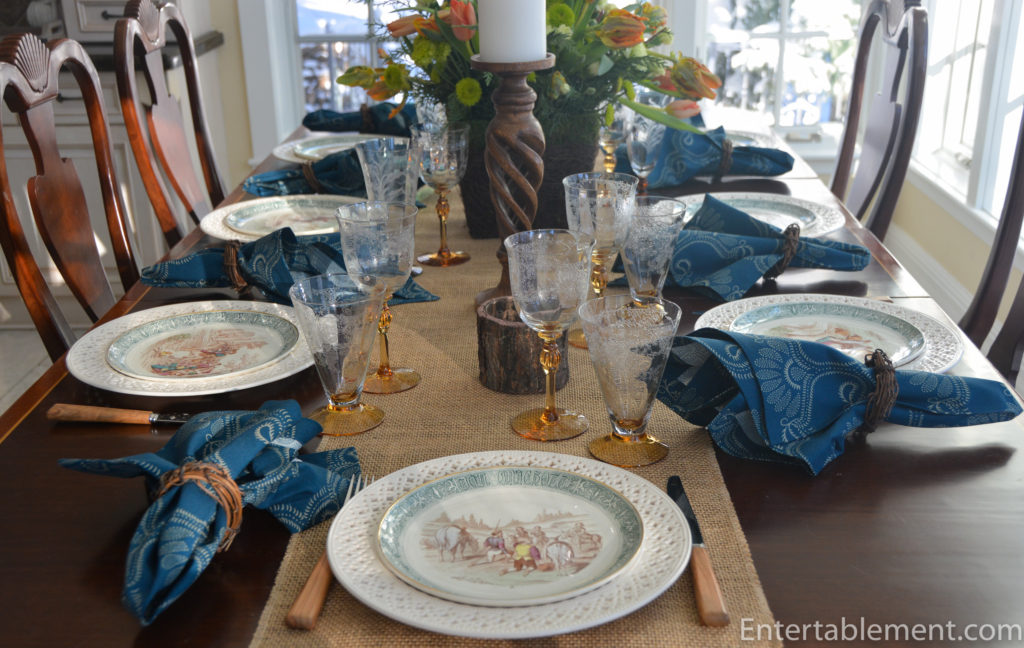




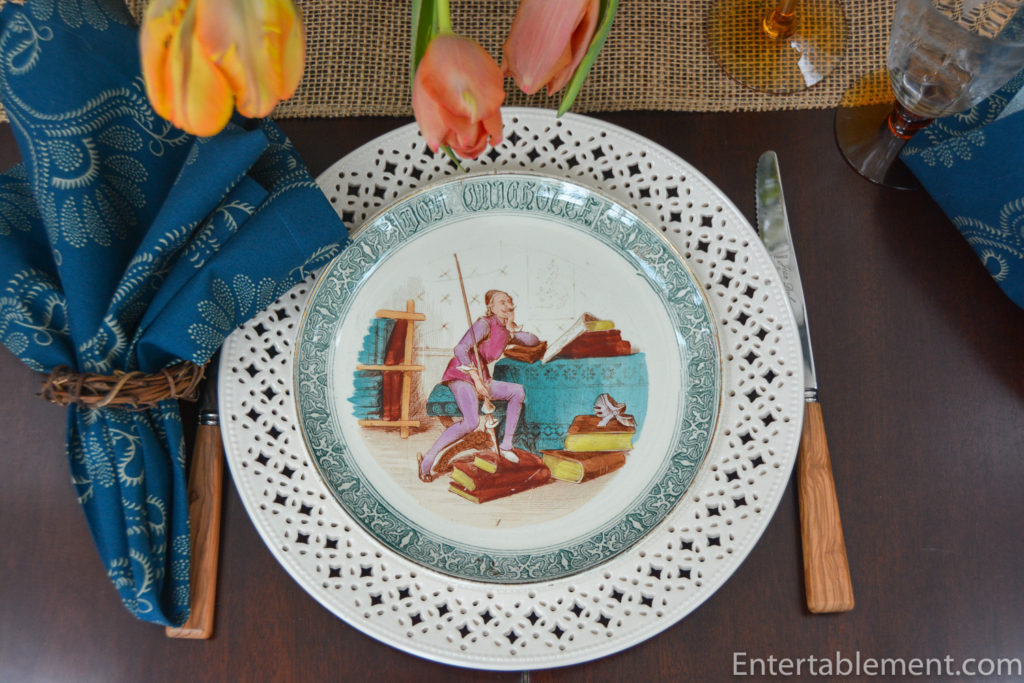
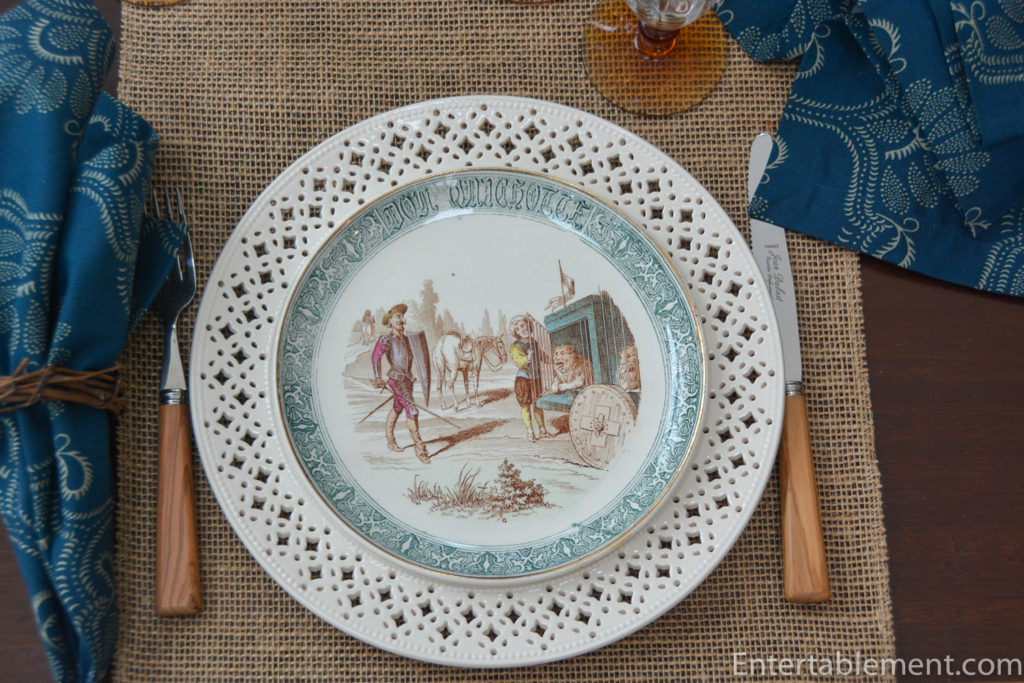

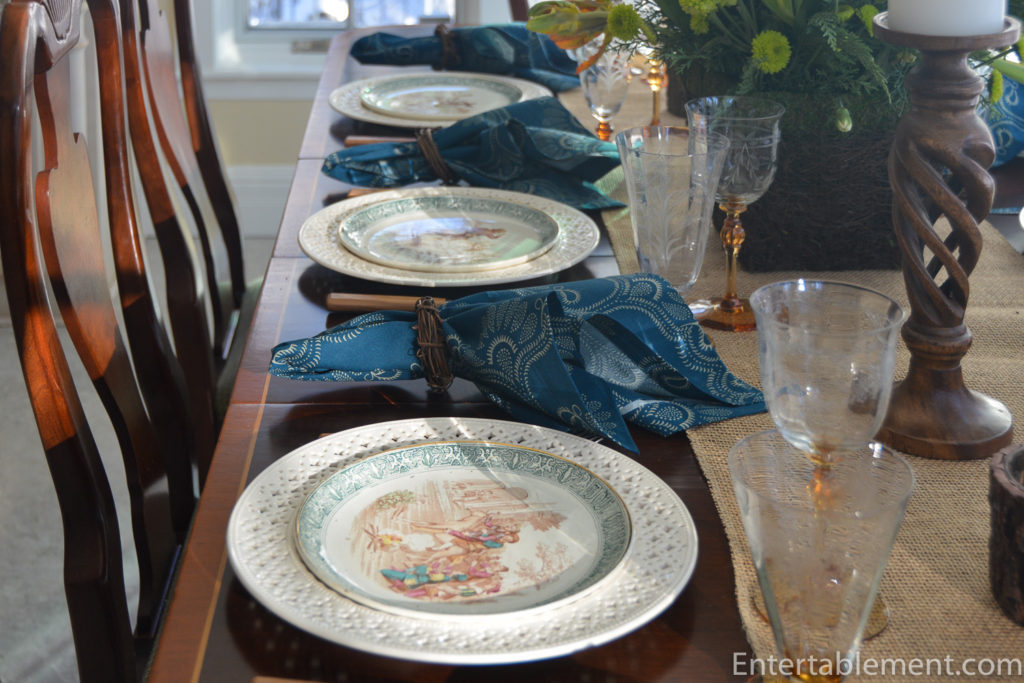








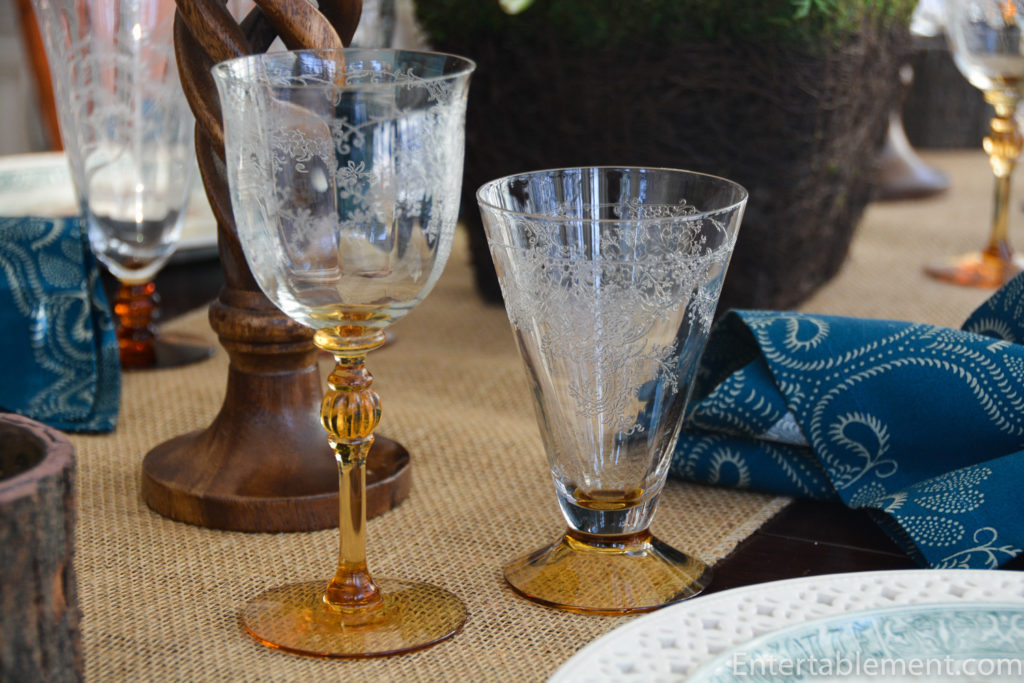

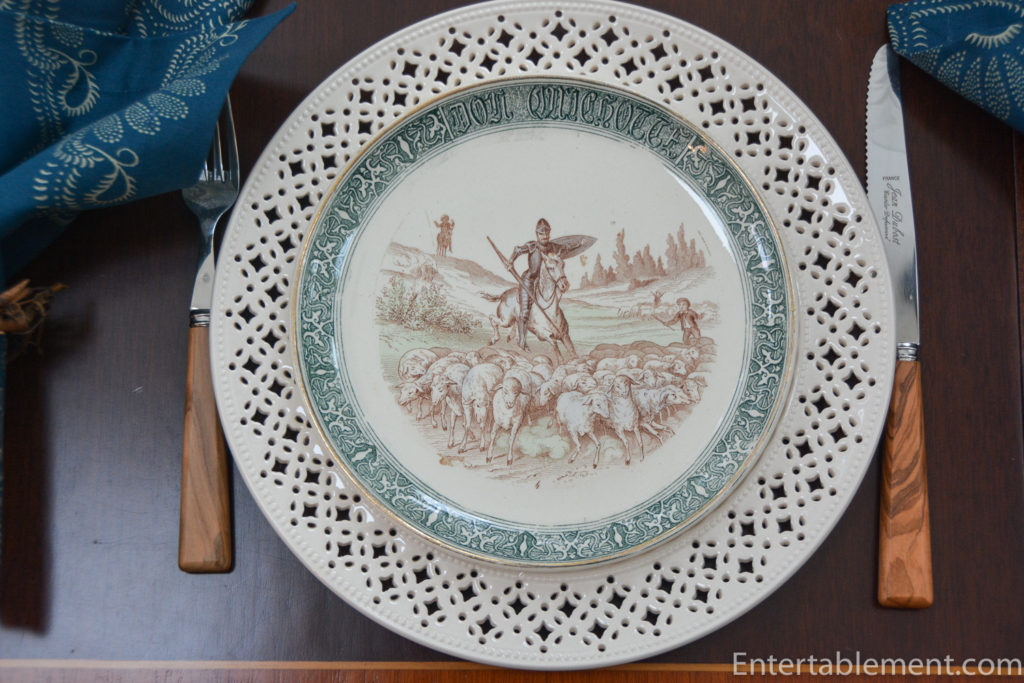
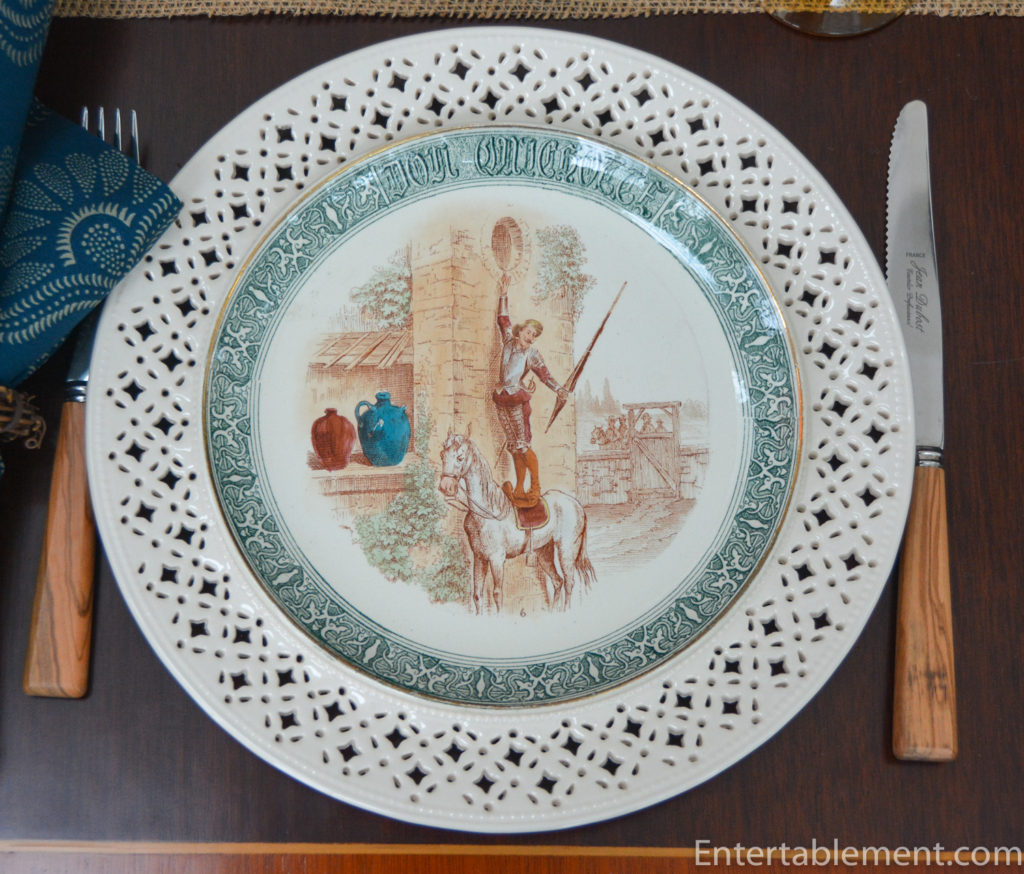

What an interesting post and very educational. I learned much more about the story than I had previously known. I think the blue napkins are the right choice and I like that they are a print but also that they are two colors. Your centerpiece flowers are lovely. Keeping my fingers crossed that you find the last plate to complete your set.
I really enjoyed researching the story, too, Lorri as it had been donkey’s years since I’d read it. As you know, I enjoy collecting series-ware – there is always so much to learn! Glad you agree on the blue choice of napkins – it was weird – the green is an odd shade. Have a good day!
What amazing conversation starters. Whether you have read the books, seen the movies, or the play or the musical—a lively conversation will certainly start with these amazing plates and table settings.
Aren’t they fun, Sandi? Thanks for stopping in! 🙂
You secured my weekend read. Thank you. Don’t know how many times I’ve read it, but it’s part of my go to rereads.
Table is sensational. Expect nothing less.Hope you have a lovely weekend. Even a cuppa’ on the deck?
There’s nothing better than a well-loved book that you can revisit any time you need a little pick-me-up. Enjoy your weekend, too, Kem. We have a freezing rain warning. Sigh…
Love the Don Quixote themed dishes, what a find! I hope you manage to snag that elusive 12th plate.
I have all my usual feelers out, but no nibbles so far. Fingers crossed, however. Thanks for joining in, Cindy!
Dear Helen,
Frightful week of working on an EU proposal; just surfaced. What an unusual theme for salad plates…been eons since I read it at school. I don’t do cobalt or yellow, but I like seeing it on others’ tables. It reads as happy and spring-y, doesn’t it, and it brings out the yellow in the plates nicely.
Freezing rain, eh? Yesterday OH sent a pic of the garden, covered in new snow (we’re at 2300ft/700mtrs). My poor narcissus–6″ tall! Looks like we’ll have a late spring, with everything blooming at once. I’ll send a pic after Easter…
EU Proposal hmmm? What a week with Brexit – ugh!!! French Faience plates have all kinds of themes, it seems. I’ve got a series of Opera plates, and I’ve seen a lot with military themes (have given those a miss).
It does indeed look like a late spring. Everything has that left-over-in-soak-too long look.
Looking forward to the pics.
Unless May can get Corbyn on board, looks like a crash-out unless Tusk can persuade France, Spain, and Belgium about his “flextension.” Guardian has good coverage…ugh, indeed.
It’s mess, mess, mess. But the Brits always muddle through somehow.
I have never seen this collection of plates and they are terrific. I love the thought of Don Quixote on the table! Yours is lovely.
They were a new discovery for me, too Linda. Always fun to have a literary themed table!
The Don Quixote plates are utterly delightful. That little old man has managed to make his story a success for so many years and in so many ways. I’ve always been slightly bemused by his universal popularity. I have to conclude that there is a bit of Don Quixote in each of us. I just received a lot of additional Hartley Green Leeds pierced dinnerware yesterday. Two more and I’ll complete my dinner plates. Next up to complete will be the luncheon plates. They are on of my favorites. I can’t quite think how you are able to leave them each Fall when you return to Canada. I’ll keep my eye open in case I come across you 12th accent plate. Thanks for sharing your wonderful design. Cherry Kay .
Hi Cherry Kay,
I’ve always been somewhat puzzled by Don Quixote’s popularity, also. It seems to me that he’s viewed more as an impractical dreamer “tilting at windmills” than anyting to aspire to (chivalrous, upholder of the underdog, etc). But as you say, there’s some of that in all of us.
Good work on the Hartley Greens Leeds plates! Your patience has been rewarded, it seems. I was fortunate enough to get mine before they discontinued the pattern; I’d been futzting around for years considering buying them and then finally bit the bullet one day. Aren’t we lucky that there are sources to buy discontinued patterns now, even if not quite as convenient as one-stop shopping? Please do keep your eye out for Don Quixote – I have an ongoing search on eBay and it turns up the most surprising finds.